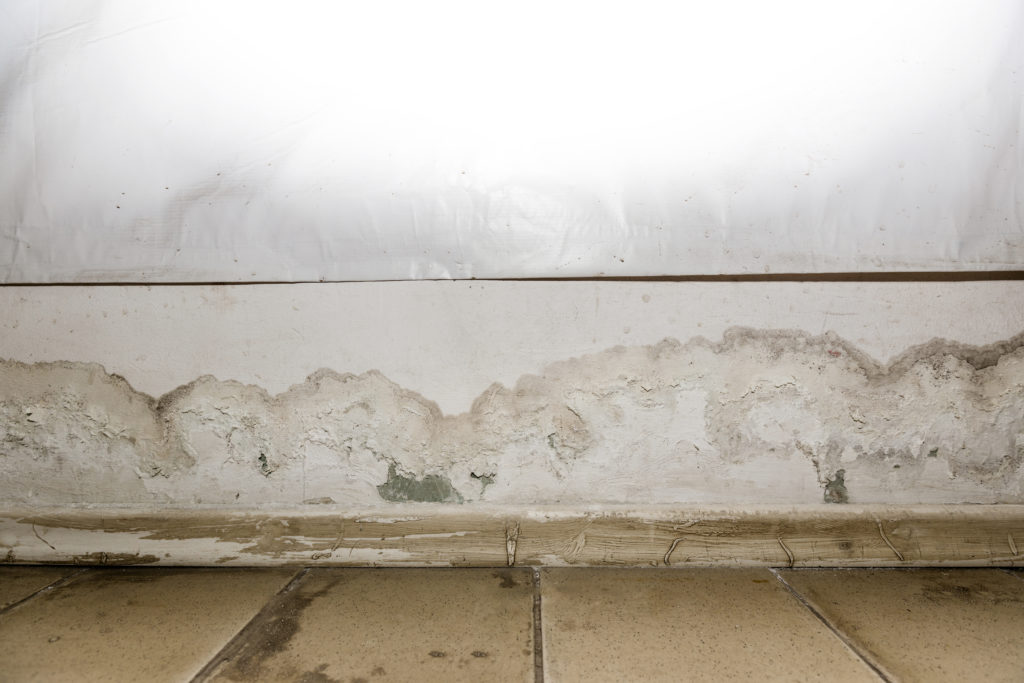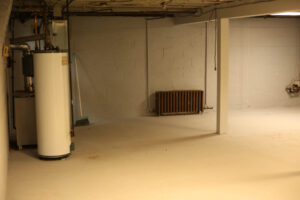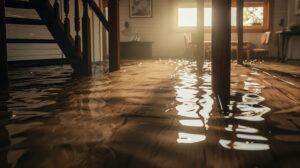Wet basement? Basement moisture is common. Basements are notoriously dark and damp. Moisture in your basement can be a problem, however common it is. Moisture can be a big problem for homeowners. Basement moisture can cause structural damage and toxic mold that is hazardous to your health. What causes basement moisture? What can you do to fix it?
Let’s start from scratch. How do you know if your basement has moisture? Identifying warning signs and symptoms is essential. A puddle of water on the floor may not be the only sign of basement moisture. Moisture can manifest itself in many ways in your basement. Here’s a quick list of a few things to look for:

- Water Trickling Out of the Walls
- Saturated Base of Concrete Walls (a ring of dampness)
- Condensation on the Walls and Floor
- Stained or Blistering Walls
- Damp, Humid Air
- Standing Water on the Floor
- Deteriorating Carpet or Wood
- Rotting Columns, Headers, and Joists
- Odor of Mold or Mildew
You may have moisture in your basement if you see any of these signs. Let’s find out where the moisture is coming from.
Basement Moisture Typically Comes From One Of 3 Sources
Rain or Groundwater
It’s outside water that makes its way inside. One inch of rain can bring 1,250 gallons of water to 2,000 square feet. ft. home. The water might find its way into your basement without proper grading, downspouts, and gutters.
Interior Moisture Sources
Water in our basements sometimes originates or is created there. The sources can include dryers, showers, cooking, humidifiers, and even newly constructed concrete.
Ventilation with Humid, Outside Air
We often open our basement windows in warmer weather. The walls and floors can condense when we let humid, outside air into our cool basements.
Identifying the possible sources of the water allows us to determine the cause and fix the problem. Check out our list of:
6 COMMON CAUSES OF BASEMENT MOISTURE AND HOW TO FIX THEM
#1. An Interior Water Leak
It may seem obvious, but you should always look for leaks inside your basement first. Showers, sinks, toilets, washing machines, dishwashers, and bad pipes can all leak water. An interior water leak can cause moisture in your basement if it’s located on the ceiling or walls beneath a bathroom or kitchen. Determine if something is leaking in the area where the moisture is.
How to Fix It: An interior leak is typically one of the easiest problems to solve. Fix the leak (or have a plumber handle it for you) and with any luck, the moisture will be gone for good.
#2. Ineffective Grading
Basements are often flooded by rain or groundwater. Your foundation should slope away from it, not towards it. Water will build up against your foundation if it drains wrong. When fill dirt around your foundation isn’t compacted properly, this occurs. As dirt settles, the slope changes and water flows toward your house.
How to Fix It: Build up the dirt around your foundation, creating a slope aiming away from the house. This should be a minimum of one inch per foot, for at least 6 feet.
#3. Missing or Defective Gutters and Downspouts
Gutter and downspouts direct rainwater away from your home’s foundation. Often, rainwater is directed toward your foundation if gutters and downspouts are missing or not functioning. Water can accumulate in the soil around your house as it drains. Water will make its way into your basement if it accumulates around your foundation.
How to Fix It: Consider adding gutters if there are none already in place. A minimum of 1 downspout should be placed per every 50 ft. of the roof eave. Water should be dispersed at least four feet away from the foundation with downspout extenders. Maintaining gutters requires regular cleaning.
#4. Cracks in Your Foundation
Water will find cracks in your foundation and find its way into your basement. Water can even cause cracks. When floor joists are not properly connected to foundation walls, cracks can form. Poor drainage in the soil can actually cause cracks in the foundation.
If water is not directed away from your foundation and accumulates against the foundation walls, and that pressure (hydrostatic pressure) can force the water into the walls, creating cracks. No matter how the cracks formed, if they exist, water can enter your basement through them.
The solution depends on the cause of the cracks. Repairing your exterior drainage should help to solve the cracks caused by hydrostatic pressure (water accumulating around the foundation). The cracks will still need to be repaired, but the cause should have been fixed. Cracks caused by structural problems should be sealed with proper footing and connections (straps or anchor bolts). Find out how to fix foundation cracks here.
#5. Poor (or Missing) Drain Tile and Sump Pit
There are many houses without a subsurface drainage system. In older homes, basements were not intended to be habitable spaces, so an under-the-floor drainage system was not necessary. Modern homes with drainage systems often have problems with them. You may have a clogged pipe, a broken connection, or a broken sump pump.
How To Fix It: Unfortunately, problems with your subsurface drainage system, or adding one where there wasn’t one, are a much more serious project than some of the aforementioned solutions. You should call a professional if you think this is your problem. It involves digging up your flooring and installing a drain system that leads to a pump that expels moisture. It’s best left to experts with tools and knowledge to build or repair a subsurface drainage system properly. Click here to get help with your drainage problems.



